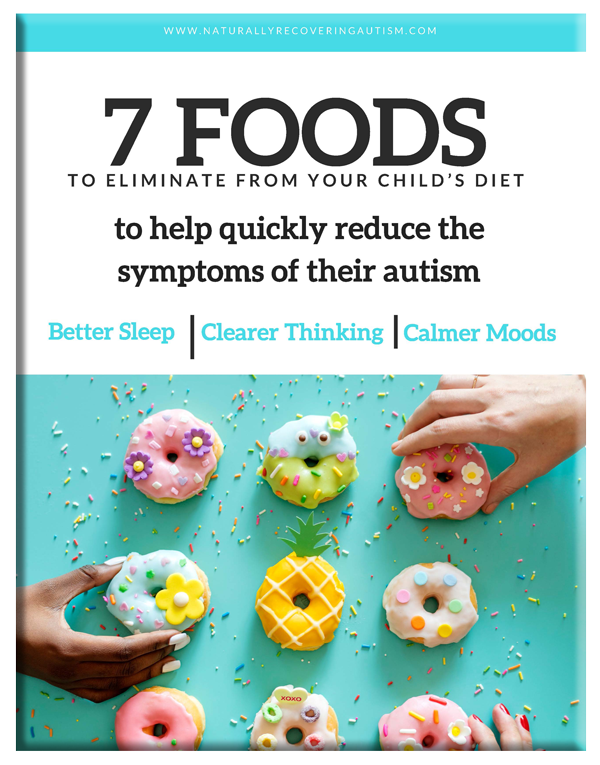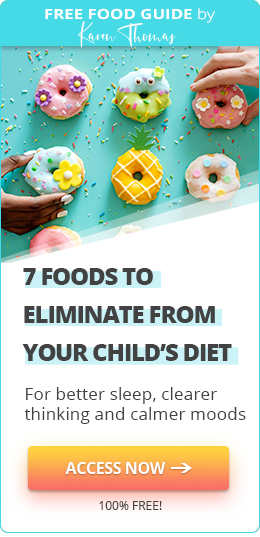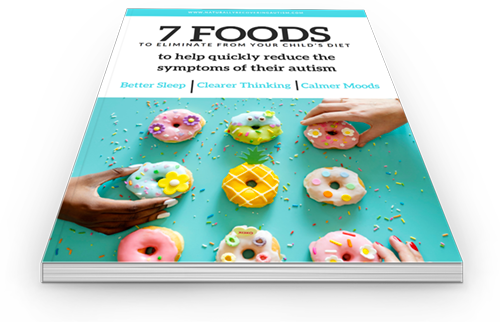Rapid Detoxification
Detoxification, even the initial phase when you’re changing the diet can cause some toxic “backlog” in your child’s body. You may notice some very heightened symptoms in this process. Rapid detoxification or die off can be too much for the body to handle and throw a person into mast cell activation syndrome (MCAS).
Since kids with autism have poor detoxification pathways we need to support them right away. Healing the gut is the beginning phase of everything. The gut controls the brain and 80% of the immune system. We begin with the right diet by removing the top inflammatory foods, supporting detoxification pathways properly, and giving only one new supplement at a time.
We use the lowest possible dosages too. Never just use a recommended dosage on any supplement bottle when working with a child with autism or it is more than likely that you will throw them into a die off reaction.
Die off reactions include worsening behaviors, increased stimming, loss of focus or speech, headaches, fever, anxiousness, stomach ache, flu-like symptoms, rash, and more.
By offering toxin binders to help sop up additional toxins that their body cannot process out fast enough, giving supplements to assist strengthening the detoxification pathways, and by supporting the liver you can help to reduce rapid die off symptoms. Always remember to move forward slowly.
Die-off is not an illness or infection, it’s a temporary syndrome in response to the process of detoxification. It is the body’s immune response to releasing toxins. As toxins break down or pathogens die, they can release harmful substances that can exacerbate symptoms. The symptoms from die off generally resolve within 3-7 days. It is when the die off symptoms do not slow down and worsen that we must look at what other issues may have been triggered.
PANS
Beyond these worsened behaviors we can throw our children into more harsh issues such as PANS, Pediatric Autoimmune Neuropsychiatric Syndrome. What this really means is an autoimmune issue where the immune system has become overactive due to fighting harder against an onslaught of toxins being released too fast and the immune system becomes overactive.
Symptoms of PANS include a rapid onset of obsessive compulsive disorder, fearfulness, clinginess, and increased anxiousness.
It is important with autism not to boost the immune system. It may already be overactive and likely is with PANS. For this reason, we need to be sure our treatment regulates the immune system. Regulating the immune system and treating infections with the right diet and the right supplements that also reduce inflammation are essential.
The goal is to keep the child stable. Triggers that contribute to a PANS flare-up include Streptococcal infections, mold biotoxins, Lyme, rapid die-off reactions from detoxification that is going too fast for the child’s body to keep up with.
Mast Cell Activation
Additionally, a very harsh symptom of rapid detoxification and the body trying to fight off the toxins and infections comes from something called Mast Cell Activation.
If you have histamine intolerance, carry a coinfection such as Lyme disease, parasitic infection, mold biotoxins or chronic inflammatory response syndrome (CIRS), or any other chronic illness, then your chances of having mast cell activation (MCA) is as much as 75%. Due to multiple infections, toxic overload, genetic issues, and chronic inflammation in children with autism it is often higher.
Mast cell activation syndrome (MCAS) is when mast cells release inflammatory mediators as defense to fight what the immune system sees as foreign agents to attack. One of these in the line of defense is histamine.
Mast cells are types of white blood cells that help to regulate the immune system. Mast cells can determine how our bodies react to environmental triggers like sugar, pesticides, perfume, pollution and other environmental toxins and all other causes of inflammation.
Mast cells are found in almost all cells of the body including the skin, gut, eyes, lungs, nerves, brain, mouth, and in the immune system. They help the immune system to stay in balance or “regulate.” Mast cells are involved in allergic reactions, and are often noted in histamine reactions. Mast cells help us heal, and they help the blood brain barrier function. The blood brain barrier helps protect your brain from toxins, but it is often damaged in people with autism.
Mast cells lie dormant until activated. Once triggered and they’ve come out, then they go where they want to. They commonly go to the nose, mouth, and the gut.
Symptoms to look for in mast cell activation:
Sensory overload, extreme anxiousness, heart palpitations, insomnia, inability to think clearly, chronic pain, hypersensitivity, fatigue, gut issues, itchy skin, wheezing, low blood pressure, diarrhea, fatigue, headaches, respiratory infections, chronic sore throat, bloating, and food sensitivities.
Autism and Mast Cell Triggers
When mast cells are activated they release a number of types of inflammatory mediators, like histamine. In turn, Histamine release causes more mast cell inflammation. Mast Cells release histamine, but they also release nearly 200 other chemicals.
Many of the 25 to 50 known mast cell triggers come from environmental triggers including:
viruses, parasites, mold, lyme, PANS/strep, injuries, allergens, foods, medications, heavy metals, pesticides, chemicals, environmental toxins, gluten, and even electromagnetic field radiation.
Additional triggers are chronic inflammation, nutrient deficiencies, genetic mutations, and medications.
Histamines and mast cells
Mast cells are our front line defenders helping the immune system recognize pathogens of all kinds. Mast cells help regulate the immune system, and protect us from environmental toxins. Histamine is a mast cell mediator. Too much histamine release causes histamine intolerance which causes mast cell activation. When this happens our protective mechanisms are broken down and we become hypersensitive to things we ingest or that are in our environment.
Close to 100% of children with autism have histamine intolerance and mast cell activation. Histamines are released by the digestive tract and the brain in defense as an allergic reaction. In histamine intolerance the body is over producing histamines and there are too many for the body to break down. This stress type response is a trigger for mast cell activation which creates a strong inflammatory response in the body. Reduced production of glutathione, the body’s master antioxidant, is also a factor.
There are also many environmental triggers for histamine release that are far lesser known. A common one is chlorine. We see anxiousness and mast cell activation sometimes after swimming in chlorinated swimming pools. Chlorine is also in tap water so if a sensitive person drinks unfiltered tap water or has a hot shower in chlorinated water and the steam opens the pores then the body absorbs it, as well as inhaling the fumes. A quality water filter is crucial to overall health.
Histamine and mast cell triggers include medications
Medications are a common trigger for histamine intolerance and mast cell activation. Antidepressants are well-known to cause this response. Even those that are supposed to help calm the system such as zoloft, prozac, or valium can trigger the opposite effect and create hyperactivity and anxiety when they trigger a histamine reaction.
Long term use can cause worse reactions that may take their toll slowly and be hard to track over time as the cause of the behavioral issues. Morphine is also a known histamine liberator. Look for hives and hyperactivity associated with ingesting it.
Nystatin is commonly used to treat yeast and fungal infections in children with autism. The effects of it are short term for its purpose and the fillers associated with it, including food dyes, corn starch, and titanium dioxide may cause heightened mood swings, anxiety, and nausea.
Even long term use of anti-histamine drugs can cause an intolerance to them and desensitize the body by blocking receptors so the body thinks it has less than it does and won’t react at all, even when it needs to for protection. Over time issues are compounded and a little anxiety can become severe anxiety, sleep and digestive issues get worse, and the brain cannot heal so behaviors become heightened.
Note that corn is a big trigger for MCA and many supplements have it as a base such as maltodextrin which is a derivative of corn. Vitamin C supplements often contain it.
Symptoms to look for in mast cell activation are similar to histamine reactions.
Symptoms from both are physical and behavioral. They can vary, but include:
- itching,
- Hives,
- rashes,
- sleep problems,
- anxiety,
- extreme mood changes,
- seizures, digestive issues
- Diarrhea
- increased stimming
- Heart palpitations
- Low blood pressure
- Headaches
- Chest pain
- Weight loss or weight gain
- Loss of appetite
- Allergens (both food and environmental)
- Gluten intolerance
- Dizziness
- Fatigue
- Vision changes
- Weakness
- Candida overgrowth
- H. Pylori bacteria
Helibactor pylori, or H. Pylori, are bacteria that are found in the stomach and duodenum (upper GI). We all carry these microbes in our GI tract. These otherwise harmless microbes become problematic when our gut flora becomes imbalanced and the cells of the stomach are damaged. Candida overgrowth is a direct cause of H. pylori problems.
Liver congestion is another culprit. When bile and toxins are frequently pushed back into the stomach, the cells become injured and weak and are then more susceptible to damage from pathogenic microbes
By reducing stomach acid histamines contribute to further issues with digestion working against your efforts to heal the gut, and is a common reason for GERD or acid back up. H. Pylori also contributes to low stomach acid levels. It is common for people to think they are too acidic when they have GERD, but the truth is to the contrary. It is that there is too little hydrochloric acid in the digestive tract. Taking a supplement of hydrochloric acid (HCL), and added pepsin can be helpful.
It is obvious to see how lowering histamines and histamine triggers in your life can naturally help, as well.
One reaction can happen without all of the others. This can make it hard to determine what the cause is. Try a low histamine diet for a week. If symptoms subside then it can be helpful in determining.
- First, it is crucial to target the root triggers. Eating low histamine foods like organic fresh poultry, grass fed beef, eggs, and line caught fish can be good. Tip: If you give good oils (coconut oil, Extra virgin olive oil) with protein it helps with nutritional absorption and keeps us full longer.
- Avoid high histamine foods like leftovers, especially of animal protein, broths simmered longer than 3.5 hours, beans, corn, fermented foods, avocados, smoked and aged foods, including dried fruit. Tip: freeze leftovers.
Leaky Gut
Yes, there is much involved in healing leaky gut and if we don’t heal up the lining of the gut that is allowing undigested foods into the bloodstream so the immune system reacts to them then it keeps happening. The gut lining has many reasons why it may have holes like candida, parasites, glyphosate (in Round-Up weed killer that is sprayed onto food crops), mold biotoxins, Lyme. We must get to the underlying core issues or the gut continues to stay ill, regardless of a good diet.
Mucosal infections are yet another trigger for mast cell activation. We know that children with autism have gut dysbiosis, so it stands that they will be susceptible to mast cell activation syndrome.
The right supplements are required along with the right diet for a long enough period of time, and getting the underlying root causes cleared. We also must support the organs of detoxification and their pathways during this process. It all takes time.
Support the liver and detoxification pathways
Histamine chemicals occur naturally in many foods. When there is leaky gut induced by candida spores, and due to toxicity and coinfections that inflame the gut then this inhibits the body’s production of the enzyme diamine oxidase, (DAO). This makes it hard for the body to break down histamines.
The diamine oxidase, the (DAO) enzyme, helps the body break down excess histamines, but commonly, this enzyme is defective in children with autism.
Inhibition of the DAO enzyme is related to leaky gut and the MTHFR gene mutation. This can happen when an ill gut blocks methylation.
The MTHFR enzyme is needed to make the enzyme methelene-tetra-hydrofolate. It plays a very important role in methylation or removing toxins from the body. Histamine needs methylation in order to be processed and eliminated from the body.
Eighty five to ninety percent of people with autism are known to have reduced methylation. Methylation is required to produce the body’s master anti-oxidant, glutathione.
When there is heavy toxic burden on the liver it has a strong demand for glutathione. Supplementing with glutathione can be very helpful as the body is detoxifying and still working to be able to produce enough of it on its own.
When the body cannot detoxify properly the toxins build up in the body and cause a myriad of health problems. With the MTHFR mutation it is important to reduce inflammatory foods from the diet as they contribute to leaky gut. Get your free guide to the top 7 foods to eliminate.
Mast Cells and Mitochondria
Mast Cell Activation affects mitochondria. Mitochondria give cells over 90% of their energy. Without proper energy cells cannot carry out their functions. Cellular energy is necessary for the function of all cells, but is particularly critical for nerve and muscle.
Both nerve and muscle are important in GI function, thus cyclic vomiting, constipation, diarrhea, poor GI mobility, and other digestive disorders are common. Additional potential complications of mitochondrial dysfunction include chronic fatigue, neuropathic pain, depression, autistic regression, seizures, hypoglycemia, visual and hearing difficulty, depression, anxiety, panic disorder, and intellectual disability.
Viral infections are among the most common triggers of mitochondrial dysfunction. Additional potential triggers are other infections such as Lyme bacteria, toxins, anesthesia, and any other significant stressor.
Viruses, Candida, Fungi and Parasites
One study released by the National Library of Medicine titled, Mast Cell Responses to Viruses and Pathogen Products states,
“Over recent years, significant progress in Mast Cell research has uncovered the responses to pathogens and pathogen products from bacteria to viruses to fungi, and the mechanisms of activation.
There is an increased propensity for bacterial and fungal infections associated with several viral infections and the widespread impact of pathogen products, beyond local sites of infection, We also need to consider that, especially in chronic or persistent infections, the ability of mast cells to mobilize acquired immune responses.
Over recent years, significant progress in Mast Cell research has uncovered the responses to pathogens and pathogen products from bacteria to viruses to fungi, and the mechanisms of activation.”
Various Candida, fungi, viruses, parasites, and many more found in this research can be seen in the table provided by the study.
Mast Cells can be activated directly by active viral infection or by contact with viral particles. Mast cells trigger cytokines (inflammation) to fight the virus’ and other pathogens.
Mast cells also release histamine in order to fight off viral, fungal, parasitic, toxins, and all other infections.
Parasites
Mast cell activation also occurs from parasite infections and bacterial dysbiosis, as well as injured intestinal lining which is a consequence of parasitic infections.
Toxins, Including Heavy Metal Toxicity
Heavy metal toxins are a huge factor in autism. The big four are mercury, aluminum, lead and cadmium.
Mercury has many dangers and detrimental effects on the body. A few notable coinciding with mast cell activation are:
- Destroys enzyme functioning creating faulty wiring of the brain
- Heavy metals can disrupt the microbiota and cause poor gut health.
- Promotes the production of inflammatory cytokines, which are essential in fighting viruses.
- Can cause lifelong immune deficiency.
- Causes a loss of glutathione
- Resists removal of the pathogenic yeast Candida albicans
- Renders the body defenseless against free radicals
- Renders the brain vulnerable to damage from excitotoxins
Aluminum affects the following neurotransmitters:
- Acetylcholine and the enzyme that breaks down acetylcholine: involved in learning and memory.
- Norepinephrine: involved in attention and focus
- Dopamine: the feel good chemical, also involved in our ability to concentrate and focus
- Serotonin: affects mood, appetite, and sleep
Lead disrupts normal brain neurotransmitter function of:
- Acetylcholine, affecting memory and motor function
- Dopamine, affecting autonomic motor control in the brain, behavior, and emotions
- Serotonin levels in the brain, which helps to regulate violence, mood, sleep and appetite.
- The GABA system, which we rely on to keep our brain signals calm; when this system is disrupted, we commonly experience anxiety.
Mold Biotoxins
The mold biotoxin illness, otherwise known as chronic inflammatory response syndrome (CIRS) is due to a cascade of inflammation from exposure to mold, common in water damaged buildings. This genetic issue is prevalent in 29% of the world population. It also creates a staphylococcus infection in the nasal passages. This creates extreme brain fog, fatigue, gut issues, depression, bedwetting, and much more.
Lyme disease
A tick or insect bite that spreads Lyme disease can trigger mast cell activation. What you’re suffering from is not necessarily chronic Lyme, but chronic Mast Cell Activation Syndrome.
A tick bite can give you one of five different rickettsial infections. These can activate the bone marrow to generate mast cells. This causes a mutation so that they become a persistent problem, and you’ve got secondary Mast Cell Activation Syndrome from Lyme.
Secondary triggers
Severe activation with secondary mast cell activation by triggers including electromagnetic field radiation. The release of toxins from molds increases up to 600 times in the presence of an electromagnetic field.
Dr. Martin Pall, specialist in Genetics, Cell Biology, and Biochemistry/Biophysics, notes that mast cell activation commonly occurs after exposure to chemicals, and is especially prevalent after exposure to electromagnetic field radiation.
There is also the Focused Life Force Energy for electromagnetic protection on your entire home or with you wherever you go if added to a phone or object always near you. Learn more from my podcast with experts on this at NaturallyRecoveringAutism.com/safe. Free 15 day trials are available for both home and phone.
Troubleshooting mast cell activation syndrome:
Questions to ask yourself when symptoms arise:
Have you had her on the PANS herbals during this episode?
Any new exposure to mold at home or school?
Any exposure to a virus or an environmental toxin that you know of?
Have they been in a chlorinated swimming pool?
Have they had any new foods or high histamine foods lately?
Has anything emotional or stressful happened recently?
Troubleshooting during detoxification is critical. This is something that took me years to find when I was on my son’s recovery journey. Had I known about it I would have saved myself a lot of time, financial expense, and reduced the stress and even panic that both my son and I lived in for so long.
Not knowing what to do is the worst. You know, that helpless feeling of knowing something needs to be done but you don’t know what that something is. The doctor says they can see you in a week or a month but you need answers now. This can be extremely stressful.
How can parents start to recover histamine intolerance and mast cell activation?
- First, it is crucial to target the root triggers. Eating low histamine foods like organic fresh poultry, grass fed beef, eggs, and line caught fish can be good. Tip: If you give good oils (coconut oil, Extra virgin olive oil) with protein it helps with nutritional absorption and keeps us full longer.
- Avoid high histamine foods like leftovers, especially of animal protein, broths simmered longer than 3.5 hours, beans, corn, fermented foods, avocados, smoked and aged foods, including dried fruit. Tip: freeze leftovers.
- Heal the gut and reduce MCA by eliminating the top inflammatory foods that are common triggers.
- Support the liver and strengthen detoxification pathways
- Get a high quality water filter
- Detoxify very slowly since rapid detoxification causes die off reactions which can cause more mast cell activation.
- Use toxin binders such as activated charcoal when symptoms heighten.
- Avoid high histamine foods.
- Allergy Relief Elixir can help neutralize excess histamines and calm mast cell activation. This is a simple clear and tasteless liquid.
- COQ10 supplementation assists mitochondria.
- Vitamins C and D3 help stabilize mast cells.
- EMF’s are very triggering to mast cell activation. An easy way to protect your family is with the FLFE placement on your phone, on your home, or on an object always around you child (free 14 day trial available). Learn more on this here.
- Treat the coinfections of autism such as Lyme disease
- Treat PANS and strep.
- Be sure your home is mold free and you properly work with mold biotoxins in the body and calm inflammation.
- Treat parasites
- Detoxify heavy metals naturally and safely.
- Balance candida
- Treat H. Pylori
- Some supplements can trigger MCA: Niacin (vitamin B3) is a trigger, so remove it for now and watch for differences.
- Beware of sensitivity to methyl folate. Many people, especially those with the MTHFR gene mutation and autism are especially sensitive to methyl folate and methyl B12. If the detoxification pathways are not prepared and strengthened prior to using methyl B12 your child may become extremely hyperactive on it.
- Beware of pharmaceutical medications that trigger histamine reactions.
- Airway obstructions that reduce oxygen levels to the body and brain. See ‘myofunctional disorders’ interview and links to resources on the show notes page for podcast #21.
- Treat underlying emotional trauma with the emotion code.
All people with mast cell activation syndrome, especially children with autism, need compassion through this. Mast cell activation can take up to a year to rebalance when triggered harshly. Your child will be extra-sensitive to environmental toxins from this.
Now it’s time to slow down. Your child’s liver cannot process fast enough to remove the toxins. If symptoms are pronounced then they could benefit from some toxin binders. Do not add in any more supplements until symptoms calm down with the exception of toxin binders and calming agents that help remove histamines.
Stay well-hydrated by drinking plenty of pure water from a quality water-filtered source. We excrete histamines through urine, so keep flushing it out. This is always important, but especially so when detoxifying.
Quickly Reduce Your Child’s Symptoms
of Autism by Eliminating 7 Specific Foods that Most People Consume Daily!
The first crucial step of autism recovery is to begin restoring health to the gut and the immune system.
The health of the gut is directly linked to the health of the brain and therefore to the symptoms of autism. In fact, 80% of the immune system comes from the gut so if the gut is not healthy, then the brain can’t thrive, and the immune system is compromised. It’s a vicious cycle, but thankfully, it’s one that we can put an end to by first eliminating harmful foods.
This is for informational purposes only and is not meant to diagnose or treat. Every child’s level of recovery is different. No two people are the same. It is never implied that all children will have the same outcome. Results are all based on individual biology and the work that is done. This process takes time and various steps, effort and resources need to be weighed. Our programs are intended to help you become more knowledgeable and guide you to help bring your child a better quality of life, whatever that may be. We want to help by giving great content, direction and strategies that move you forward. Nothing on this page or any of our websites is a promise or guarantee of results or future outcomes. The results on this page and any of our websites are not typical or promised. In fact, there will be people who purchase this and other programs and never put the work into implementing the strategies taught and therefore will achieve little to no results. Our more detailed earnings disclaimer, privacy policy, and terms and conditions for this program and website can be accessed via the links below. We hold ourselves (and you) to a high standard of integrity. We are cheering you on every step of the way.











